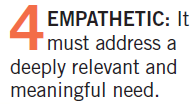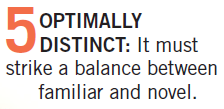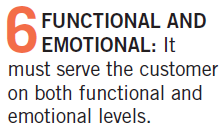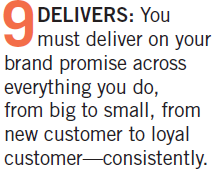Marketing: 9 Companies That Get Brand Right

It’s tougher than ever to grab and hold customers' attention. People are overwhelmed by messages flying at them from all directions, and it’s easy for yours—or your client’s—to get drowned out. Many companies ignore brand strategy, but that’s a huge mistake. A compelling brand strategy is the best way to earn customer loyalty.
The best brand strategies must meet nine criteria. Here is that list of nine, plus some real-world examples of companies that get them right:

This is the space you own in your customer’s head. Make it a big space, a big promise. This will create value for both your customer and your business. By mattering to your customer, you fuel a business that matters.
Example: Salesforce enables leaders to grow their businesses faster. This is a large and resonant promise for Salesforce’s target customer. A less big alternative might have been “track customer communication carefully” or “largest storage capacity among CRM solutions.” With its big promise, Salesforce is a beloved brand with a tremendous market capitalization.
––––––––––––––––––––––––––––––––––––––––––––––––––––––––––––––––––––––


While your brand positioning must be big enough to matter, it also must be narrow enough for you to dominate. Choose a positioning you uniquely can own—one where you are not just better, but you are different.
Example: Dollar Shave Club chose a meaning narrow enough to own. They unabashedly targeted Millennial males not loyal to the status quo way of buying shaving materials. With a subscription-based razor delivery model, Dollar Shave Club outflanked Gillette by not distributing through traditional retailers.
––––––––––––––––––––––––––––––––––––––––––––––––––––––––––––––––––––––

Promise and deliver from your place of dramatically asymmetrical strength. (It’s asymmetrical because your edge comes not from being OK at a lot of things, but from being excellent at one thing.) Your positioning must pinpoint precisely what only you can bring to your customer that others cannot copy.
Example: GORE-TEX has an asymmetrical advantage in waterproof fabrics. By inventing and patenting the technology for their fabric in 1969, they claimed the gold standard in waterproof fibers. As a result, GORE-TEX waterproof fabric is used in products manufactured by Patagonia, L.L. Bean, Oakley, Marmot, The North Face and others.
––––––––––––––––––––––––––––––––––––––––––––––––––––––––––––––––––––––


Your positioning must genuinely have your customers’ interests at heart. Ironclad brands genuinely care about their customers and seek to serve them with authenticity.
Example: Airbnb empathetically addresses a large and previously unserved desire. Based on a promise to “belong anywhere,” Airbnb marries two deep, human needs: the need to belong and the need to feel safe in parts of the world beyond our experience. The Airbnb promise is meaningful for guests, who get to experience a new place through the lens of a local, and hosts, who get to share their world with someone they’d otherwise never meet.
––––––––––––––––––––––––––––––––––––––––––––––––––––––––––––––––––––––

Your brand positioning must be recognizable enough that your customer can easily grasp it, and yet new enough that it breaks through clutter and sparks intrigue. Familiarity gets you into the customer’s mind, while novelty attracts the customer’s attention.
Example: Chobani yogurt blends the distinctness of Greek-style yogurt with the familiarity of mainstream American yogurt. Fage made the mistake of being very different—a difficult-to-pronounce name (“Fa-yeh”), large cartons, plain whole milk SKUs—and never broadly tapped into Americans’ yogurt-eating habits. Mainstream American brands like Yoplait had become ho-hum, uninteresting—overly familiar. Chobani blended familiar (traditional American fruit flavors and single-size servings) with novel (Greek yogurt’s thick texture), growing it to be one of the largest brands in the yogurt category.
––––––––––––––––––––––––––––––––––––––––––––––––––––––––––––––––––––––


Your offering must be at the critical intersection of your customer’s heart and mind. If it’s only emotional, they might not believe it. If it’s only functional, they won’t bond with it or be loyal to it.
Example: Etsy gets it just right by promising “something real from a real person”—an ideal intersection of functional and emotional. They bring the functional benefit of making it easy to find makers of what you need along with the emotional, soul-satisfying payoff of buying from a real artisan. It is functional enough to assuage the mind and emotional enough to capture the heart. In contrast, Microsoft Office is a brand that is overly functional—it is all about the product’s features and does nothing for your heart. And Jaguar is a brand that is too emotional—while the heart loves style and luxury, the mind can’t accept that it requires frequent repairs.
––––––––––––––––––––––––––––––––––––––––––––––––––––––––––––––––––––––

Sharp-edged: It must entail a single, sharp-edged promise.
Your brand positioning must be simple and singular. It should be ridiculously clear to customers what you do and don’t promise. Focus on that specific benefit with all you do and stay supporting that single idea.
Example: Let’s look at a few well-known car brands. When you say Volvo, I say safe. When you say Prius, I say fuel-efficient. When you say Jeep, I say fun. None of these brands overextend into being sporty, prestigious or fast. It’s clear what they do and what they don’t do. But when you say Buick, it doesn’t mean much. That’s a brand without sharp edges.
––––––––––––––––––––––––––––––––––––––––––––––––––––––––––––––––––––––


Has teeth: It must be demonstrably true.
Your positioning must offer compelling, granular, concrete proof that it will deliver on its promise. It need not only be true, but demonstrably true. This helps customers believe it, trust it and engage with it.
Example: Plenty of insurance companies pitch a savings advantage. However, only Geico’s promise to save you money on car insurance is extremely specific, with numerical, relevant facts to back it up: “Fifteen minutes could save you 15 percent or more on car insurance.” Fifteen minutes is fast, but not so fast that it’s not believable. Fifteen percent is substantial but does not sound like an overpromise. The matching of “15 minutes” with “15 percent” makes the promise memorably specific.
––––––––––––––––––––––––––––––––––––––––––––––––––––––––––––––––––––––

You don’t just nail the letter of the promise, but the spirit of the promise.
Example: Zappos promises world-class customer service and delivers on that consistently and across all dimensions. They hire people for their customer service ethic. Their processes are set up to reward creative, above-and-beyond ways to delight customers. They will get your merchandise to you in 24 hours. They provide free shipping both ways. Even their boxes are a treat to open. They deliver excellent customer service in spades.
For a brand to meet these criteria, leaders must make difficult choices and trade-offs. It can feel scary to decide so boldly and shine a spotlight on what you have selected. Yet choosing is what separates good leaders from great leaders, what separates flash-in-the-pan businesses from the ones that endure for generations.
––––––––––––––––––––––––––––––––––––––––––––––––––––––––––––––––––––––
Lindsay Pedersen is the author of Forging an Ironclad Brand: A Leader’s Guide. She is a brand strategist, board advisor, coach, speaker and teacher known for her scientific, growth-oriented approach to brand building. She developed the Ironclad Method for value-creating brands while working with billion-dollar businesses like Starbucks, Clorox, Zulily, T-Mobile and IMDb, as well as many burgeoning start-ups. Pedersen lives in Seattle with her husband and two children. www.ironcladbrandstrategy.com

